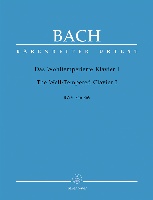Was Gott tut, das ist wohlgetan (What God does is well
done), BWV 98, is a church cantata by Johann Sebastian
Bach. He composed it in Leipzig for the 21st Sunday
after Trinity and first performed it on 10 November
1726.
In his fourth year in Leipzig, Bach wrote the cantata
for the 21st Sunday after Trinity and first performed
it on 10 November 1726. It is regarded as part of his
third annual cycle of cantatas. The prescribed readings
for the Sunday were from Paul's Epistle to the
Ephesi...(+)
Was Gott tut, das ist wohlgetan (What God does is well
done), BWV 98, is a church cantata by Johann Sebastian
Bach. He composed it in Leipzig for the 21st Sunday
after Trinity and first performed it on 10 November
1726.
In his fourth year in Leipzig, Bach wrote the cantata
for the 21st Sunday after Trinity and first performed
it on 10 November 1726. It is regarded as part of his
third annual cycle of cantatas. The prescribed readings
for the Sunday were from Paul's Epistle to the
Ephesians, "take unto you the whole armour of God"
(Ephesians 6:10–17), and from the Gospel of John, the
healing of the nobleman's son (John 4:46–54). The
cantata opens with the first stanza of the chorale,
"Was Gott tut, das ist wohlgetan" (1674) by Samuel
Rodigast, but it is not a chorale cantata in the strict
sense of Bach's second annual cycle, cantatas on the
stanzas of one chorale. He had then treated the same
chorale completely in Was Gott tut, das ist wohlgetan,
BWV 99 (1724), and would do it later once more in Was
Gott tut, das ist wohlgetan, BWV 100 (1732).
The text of the chorale concentrates on trust in God,
whereas the two cantatas previously composed for the
occasion, Ich glaube, lieber Herr, hilf meinem
Unglauben, BWV 109, and Aus tiefer Not schrei ich zu
dir, BWV 38, both started from doubt and distress. The
unknown poet refers to general ideas from the gospel.
He stresses that a prayer for salvation will be
granted, in movement 4 according to Matthew 7:7,
"knock, and it shall be opened unto you", and he
continues in movement 5, paraphrasing Jacob in Genesis
32:26, "I will not let you go, except you bless me".
This final movement is not a chorale, although its text
begins like one, Christian Keymann's "Meinen Jesum laß
ich nicht" (1658).
The cantata is scored like chamber music, especially
compared to the chorale cantatas on the same chorale
with a melody by Severus Gastorius. In the opening
chorus, the mostly homophonic setting of the voices,
with the oboes playing colla parte, is complemented by
strings dominated by the first violin as an obbligato
instrument rather than an independent orchestral
concerto. The final line is in free polyphony, extended
even during the long last note of the tune. All voices
have extended melismas on the word "walten" (govern),
stressing that God is "ultimately in control". Strings
and voices alternate in the bar form's two Stollen, but
are united for the Abgesang.
Both recitatives are secco. The first aria is
accompanied by an obbligato oboe. The first two
measures of its theme are derived from the chorale
tune. The ritornello is repeated after a first vocal
section, "cease weeping and remain patient", and a
second time, concluding a different vocal section,
which renders "God's resoluteness" in a stream of
triplets in the voice. The second aria is the final
movement, dominated by the violins in unison in a
similar structure as the first, two vocal sections
framed by repeats of a ritornello. Bach hints at the
regular closing chorale by beginning the vocal part
with an embellished version of the first line of the
hymn "Meinen Jesum laß ich nicht" on a melody by
Andreas Hammerschmidt on the same words as the cantata
text. The first line appears in four of five entries of
the voice.
Although originally scored for four vocal soloists
(soprano, alto, tenor and bass), a four-part choir, two
oboes, taille (tenor oboe), two violins, viola, and
basso continuo, I created this arrangement for French
Horn & Concert (Pedal) Harp.





 Faire un don
Faire un don